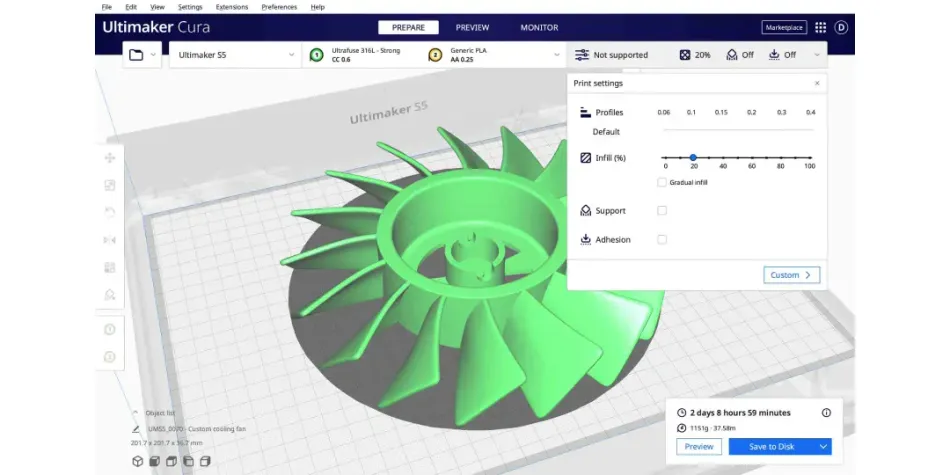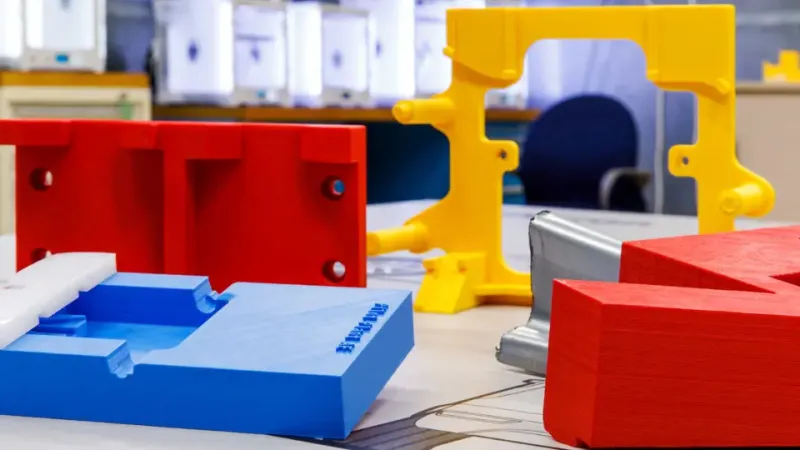What is the strongest 3D printing material?
Whether you are a hobbyist or an expert, most of your projects need materials that are strong and tough. With this article, we aim to compare the toughest 3D printing materials and provide you with an answer.
It won’t be an overstatement to say that most of you reading this article have often wondered ‘which 3D printing material is the strongest?’ It is surely an intriguing question. One that everyone wants to know the answer to. Whether you are a hobbyist or an expert, most of your projects need materials that are strong and tough. With this article, we aim to compare the toughest 3D printing materials and provide you with an answer.
But this also begs the question of what strength means for 3D printing materials?
What does ‘strong’ mean when it comes to 3D printing?
Well, strength in 3D printing materials can be defined in a number of ways. Some of them include hardness, impact resistance, compressive strength, and so on. However, two of the most commonly understood types of strength that most people care about are tensile strength and flexural strength. That is how much a material can be stretched and bent respectively. In the following overview, we will list the MegaPascal (MPa) of pressure that each material can endure. The higher these numbers, the ‘stronger’ the material when subjected to those particular stresses. The numbers we use are based on the technical datasheets for Ultimaker materials. Materials from other brands may vary.
Best FFF/FDM materials for printing strong parts
For our comparison of the strongest 3D printing materials, we will be considering seven different materials. Namely, Polylactic Acid (PLA), Tough PLA, Acrylonitrile Butadiene Styrene (ABS), Polycarbonate (PC), glycol-modified polyethylene terephthalate (PET-G ), Nylon, and Polypropylene (PP). Which one is best for you depends on your needs, budget, and a number of other factors. Later in this article, we will discuss specific applications and which material may be best for them.
PLA filament
PLA, or polylactic acid, is a highly versatile and popular FDM 3D printing material. Its popularity stems from the fact that it is simple to print, easily available at low prices, and comes in a variety of colors. For that reason, it’s likely the first material most people will print with.
PLA is not usually chosen for its strength properties, due to the material being brittle. If you are printing on a budget, PLA can be appropriate in some cases but if your part needs to flex before breaking, you are usually better off using a different material.
PLA filament properties
Tensile Strength: 53-59 MPa
Flexural Strength: 97-101 MPa
Tough PLA filament
Tough PLA is a tougher version of regular PLA or Polylactic Acid. It combines the ease of printing that one can expect from PLA and takes away the main disadvantage of PLA: its brittleness. For this reason, it’s ideal for functional prototypes that need a bit of flex.
Tough PLA is not as brittle as regular PLA, it exhibits higher tensile strength than ABS, is easier to print than ABS, and is compatible with the water-soluble support material PVA.
Tough PLA filament properties
Tensile Strength: 45-48 MPa
Flexural Strength: 83-96 MPa
ABS filament
ABS, also known as acrylonitrile butadiene styrene, is a popular thermoplastic polymer. It is well-known for its impact, chemical, water, and heat resistance. It also has outstanding high and low-temperature performance, which makes it perfect for automotive components. ABS also has good electrical insulation properties, making it a good choice for the housing and casing of electrical parts.
Furthermore, ABS is comparatively cheaper than most materials and is relatively easy to post-process. As a result, it is an excellent material for mass production and is used in a wide range of common products. The fact that ABS is simple to post-process also means it can be bonded and painted.
ABS filament properties
Tensile Strength: 34-36 MPa
Flexural Strength: 60-61 MPa
Polycarbonate (PC) filament
Polycarbonate filament (PC) is a stiff thermoplastic polymer that is resistant to heat and chemicals. It is a high-strength material designed for use in harsh environments and technical applications. It has good heat deflection due to its high glass transition temperature and it is typically available in a version with improved impact resistance as well.
Polycarbonate filament has numerous applications in everyday life. Polycarbonate, unlike plexiglass, does not shatter. It bends and deforms similarly to hard rubber until it finally breaks. It also has excellent optical clarity.
Polycarbonate can be difficult to work with due to its high temperature resistance, meaning that warping can be an issue. Choosing the correct glue and avoiding sharp angles in your parts can help you print successfully with this material.
Polycarbonate filament properties
Tensile Strength: 43-65 MPa
Flexural Strength: 89-114 MPa
PETG filament
PETG, or Polyethylene Terephthalate Glycol, is a thermoplastic polyester that has been chemically modified with the addition of Glycol to limit crystallization and improve toughness. The inclusion of glycol improves PET’s , durability and formability for production. It has a strong impact and abrasion resistance and can sustain higher temperatures compared to PLA.
Because of its excellent properties and relatively low price, PETG is commonly used in 3D printing. It is a good engineering-grade material that can be used in place of ABS. It also has less of a tendency to warp, which means it's easier to print accurate parts.
PETG filament properties
Tensile Strength: 38-44 MPa
Flexural Strength: 75-79MPa
Nylon filament
Nylon for 3D printing is commonly found in several forms: PA6 and PA6/66, which are stiffer versions of Nylon, and PA 12, which is a flexible type of Nylon. Nylon has helpful qualities that make it an appealing material for 3D printing. Nylon is both strong and durable, as well as flexible. This characteristic is beneficial when printing pieces with thin walls. Furthermore, nylon has a high melting point with a very low coefficient of friction, allowing it to be used in the printing of functional interlocking items such as gears.
One major disadvantage of nylon as a 3D printing material is that it is highly hygroscopic, which means that it absorbs moisture. This can make it difficult to achieve the expected performance when printing.
Nylon filament properties
Tensile Strength: 63-65 MPa
Flexural Strength: 63-83 MPa
Polypropylene (PP) filament
Polypropylene (PP) is a widely used plastic that may be found in almost any household. It is the material of choice for storage and packaging applications as well as many traditional forms of manufacturing like injection molding. The popularity of PP is due to its high chemical resistance, heat resistance, impact resistance, and flexibility.
Its qualities make it perfect for applications such as food packaging, outdoor exposure, chemical storage tanks, and even medical applications like prosthetics, among others.
Polypropylene Filament Properties
Tensile Strength: 10-12 MPa
Flexural Strength: 13-15 MPa
Best settings for printing strong parts

Wouldn't it be great to be able to print stronger parts even without changing the material you’re using? Luckily, it is possible. The key is to optimize your settings. To get the most out of your printer and material, you must customize the settings you use for not only each material, but also each part.
Below are some of the best settings to modify to strengthen your part:
Infill type and density: Infill type and density are important contributing factors toward the strength of a printed part. The greater the infill density, the greater the strength. However, a high infill density is not usually advised as it uses up a lot of material and takes more time to print. To increase the strength of a part without increasing the density, you can also change the infill pattern depending on the part functionality. For example, in compression strength tests, triangle/grid infill shows higher compression strength versus cubic and gyroid infill patterns
For most visual prints, you can use an infill of around 20 percent, but for stronger parts, try going over 50 percent. An alternative is to use modifier meshes to selectively generate higher infill density in the areas where the stresses will be the highest.
Part Orientation: Part orientation may not be on your checklist of steps to ensure a stronger print, but it is crucial. Tensile strength is weaker along the Z-axis in 3D printing (typically 40-70% of the strength when compared to the XY-axis), especially in tall and thin printed parts. As a result, you must carefully orient the part to match the required axis of strength. While doing this, you will also have to take into consideration the support structure and a balance will have to be found based on what matters most in that particular part.
Shell Thickness: The outer surface thickness of the part is referred to as its shell thickness. Generally speaking, the thicker the shell, the stronger the part. Based on this, you can decide the shell thickness you need for your part. A shell thickness which is double the layer thickness is usually a good place to start.
Post-processing for stronger parts
The work is not finished once a part is printed. It’s possible to increase the strength of your printed part with a little extra work.
Annealing: Semicrystalline materials like Nylon, PET, PEEK and some forms of PLA can be annealed. This is thermal treatment where the material is fully transformed in its crystalline state, giving you a stiffer and stronger part.
Applications for strong printed parts

Strong printed parts have a wide range of applications spread across industries and functions. The following are examples of applications where strength is critical along with which materials you may want to consider using:
Functional prototypes: Functional prototypes are meant to test and demonstrate the final functionality of the product being developed. Functional prototypes are rigorously tested so that accurate data can be gathered on the behavior of the part during real-world performance. This means that the characteristics of the prototype and the final product must match so that the data generated during the testing phase can be trusted. Because functional prototypes are prone to wear and tear, they must be robust. For this application, tough PLA and PET-G filaments are commonly used. Although, any material can be appropriate as long as it shares the properties of the material which will eventually be used for mass production.
End-Use Components: When printing end-use parts, improved strength characteristics greatly increase the number of end-use applications that 3D printing can be used for. Polypropylene is commonly used for parts such as prosthetics, polycarbonate is used for eyewear and electronic casings, and polypropylene, PET-G, or PEEK are often used for applications requiring chemical contact.
Manufacturing Aids: These are the tools and devices that assist in the manufacturing of parts. These are also used during the assembly stage to speed up the assembly of parts. Stronger prints are recommended for this application because they can experience a lot of wear and tear with repeated use. Nylon and PET-G are often appropriate materials to use here.
